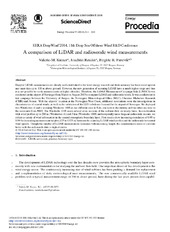A Comparison of LiDAR and Radiosonde Wind Measurements
Peer reviewed, Journal article
Published version
Permanent lenke
https://hdl.handle.net/1956/9459Utgivelsesdato
2014Metadata
Vis full innførselSamlinger
- Geophysical Institute [1198]
Originalversjon
https://doi.org/10.1016/j.egypro.2014.07.230Sammendrag
Doppler LiDAR measurements are already well established in the wind energy research and their accuracy has been tested against met mast data up to 100 m above ground. However, the new generation of scanning LiDAR have a much higher range and thus it is not possible to verify measurements at higher altitudes. Therefore, the LiDAR Measurement Campaign Sola (LIMECS) was conducted at the airport of Stavanger from March to August 2013 to compare LiDAR and radiosonde winds. It was a collaborative test campaign between the University of Bergen, the Norwegian Meteorological Office (MET), Christian Michelsen Research (CMR) and Avinor. With the airports’ location at the Norwegian West Coast, additional motivations were the investigations in characteristics of coastal winds, as well as the validation of the LES turbulence forecast for the airport of Stavanger. We deployed two Windcubes v1 and a scanning Windcube 100S at two different sites in Sola, one next to the runway and the other one near to the autosonde from MET. The Windcube 100S scans several cross-sections of the ambient flow on hourly basis. In combination with wind profiles up to 200 m (Windcubes v1) and 3 km (Windcube 100S) and temporally more frequent radiosonde ascents, we collect a variety of wind information in the coastal atmospheric boundary layer. First results show increasing correlation of 0.95 to 0.99 for increasing measurement heights (125 to 1325 m) between the scanning LiDAR wind profiles and the radiosonde horizontal wind speeds. Though the number of LiDAR measurements decreases with increasing height, the measurements seem to correlate better with the radiosonde data in high altitudes.

